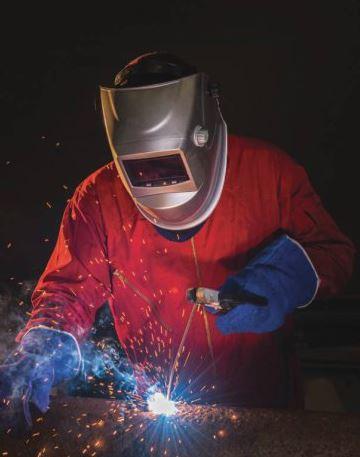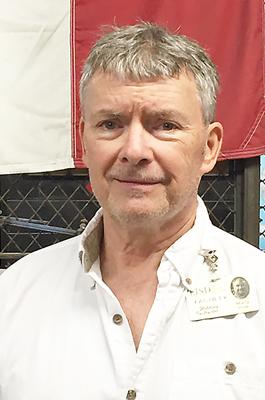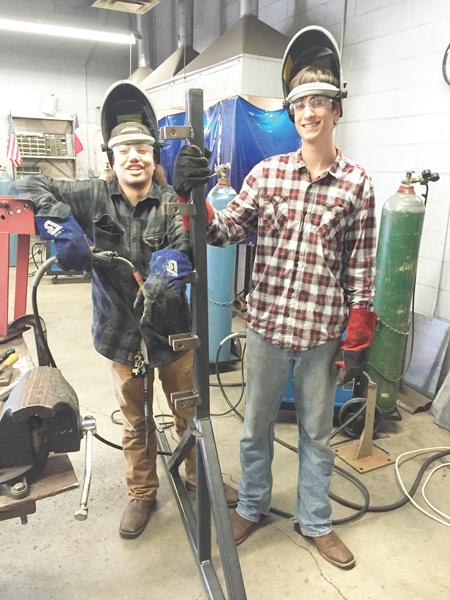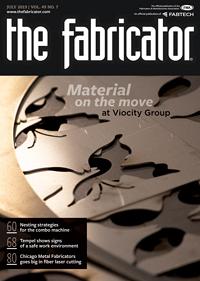Contributing editor
- FMA
- The Fabricator
- FABTECH
- Canadian Metalworking
Categories
- Additive Manufacturing
- Aluminum Welding
- Arc Welding
- Assembly and Joining
- Automation and Robotics
- Bending and Forming
- Consumables
- Cutting and Weld Prep
- Electric Vehicles
- En Español
- Finishing
- Hydroforming
- Laser Cutting
- Laser Welding
- Machining
- Manufacturing Software
- Materials Handling
- Metals/Materials
- Oxyfuel Cutting
- Plasma Cutting
- Power Tools
- Punching and Other Holemaking
- Roll Forming
- Safety
- Sawing
- Shearing
- Shop Management
- Testing and Measuring
- Tube and Pipe Fabrication
- Tube and Pipe Production
- Waterjet Cutting
Industry Directory
Webcasts
Podcasts
FAB 40
Advertise
Subscribe
Account Login
Search
Shielded metal arc welding (SMAW) primer
Q & A with retired welding guru, instructor, and columnist Marty Rice
- By Kate Bachman
- July 10, 2019
- Article
- Arc Welding

Shielded metal arc welding uses current flowing through a steel rod, called an electrode, in an electrode holder. When the welder touches the rod to the steel, the arc creates an arc force, the resistance creates heat, and that heat melts the rod. The rod actually burns and becomes filler metal that melts into the steel.
1. How is SMAW done, in a nutshell?
My brother was very unmechanical and he would ask me, “Are you going to do that process with jumper cables and a sparkler?” That’s not the most scientific explanation, yet, in a way, SMAW is kind of like that.
You’ve got alternating or direct current flowing through a steel rod, which is why we call it stick welding—it kind of looks like a stick. You put the rod—called an electrode—in a stinger, or electrode holder. When you touch it to the steel you want to join, the arc creates an arc force, the resistance creates heat, and that heat melts the rod. The rod actually burns and becomes filler metal that melts into the steel (fusion) and they become one, Grasshopper.
2. What are some welding mistakes or defects?
You’ve got to do it just right. There are three major weld defects.
Undercut. One is undercut, which is the cardinal sin. That’s where you cut into the steel and don’t replace it with filler metal. This can result in longitudinal cracks that can cause the weld to fail.
Porosity. And then there’s porosity, which causes little wormholes in the weld and weakens it. You have to have shielding gas; otherwise, it can get porous. The shielding gas protects that molten puddle from the atmosphere, which has hydrogen, nitrogen, carbon dioxide … all the different gases that will contaminate a weld. So you always have to protect your weld from the atmosphere no matter what process you’re using. With SMAW, there is a flux coating on the rod itself, and that flux creates a shielding gas when you burn the rod. The shielding gas is inert, which means it won’t allow the elements in the atmosphere to contaminate the weld pool.
Slag inclusion. And then there’s slag inclusion. After you melt the rod, when the flux is burned, it turns into slag, which is a protective coating on the weld. You have to chip it and brush it off. If you’re not careful, you can weld over a piece of slag and then that slag becomes part of the weld, and that weakens it. There are others, but these are the three main defects that can cause a weld to fail, which could result in structural damage, injury, and even death.
3. Are there some tips and tricks or rules of thumb for SMAW?
You betcha. I had an instructor, Phil Newell, over 40 some years ago. I can still hear him yelling in my ear: “Relax your hand!” and “Watch the weld pool!” Those are the two main things you’ve got to do, especially with stick welding.
That’s hard, especially for guys. My girls have always done well because they relax their wrists; no problem. Guys … I guess we’re too macho or something. After all these years, I even find myself tensing up my wrist. You’ve got to be completely relaxed so your weld pool will go right where you want it to go. I tell my students, relax so much that you’re about to go to sleep but don’t! And then keep your eyes on the weld pool.
Most new welders look at the arc. The arc produces a light, and your eyes are drawn to that light. But you don’t want to look at that arc light; you want to look right underneath it at the weld puddle or the weld pool. Depending on the lens you’re using, it’s kind of orange, an orange molten-like lava pool. That is what you want to keep your eyes on while you’re welding. You manipulate it and try to keep a uniform amount and control where it goes.
Your manipulation of the rod goes along with that. You have to oscillate back and forth, like an oscillating fan. What manipulation you use depends on which rod you use. Some rods, you just drag them. Some you can barely move up and down as you’re dragging them. Some, you can do a little “C” motion, and some you can even do a circle. But the main thing is to relax your wrist, like an artist painting, and watch that weld pool. Otherwise, you won’t get a smooth weld bead. There is somewhat of an art to it.

Editor’s Note: Marty Rice has stepped out of recent retirement briefly to respond to some questions from The FABRICATOR® about shielded metal arc welding (SMAW). In responding to the questions, he brings his considerable experience as an ironworker (now an honorary member of the Iron Workers Local 263), Dale Jackson Career Center welding instructor, welding accreditation consultant, Practical Welding Today columnist, and thefabricator.com author.
Three things go along with that. One is your travel speed; most welders go too fast when they first start stick. And there’s your temperature; your amps setting for your heat. And third is the rod angle. Along with those, you need the correct rod diameter for the thickness of the steel you’re using. But the three main things are travel speed, temperature, and rod angle.
Everyone can get it if they’re willing to put in the work. I tell my students, “You gotta burn to learn.” And I always taught self-pacing, because some people take a little longer. If you’re willing to burn, you’ll learn. You just gotta do it over and over and over again. If you’re willing to go in there and burn rod after rod after rod, you will get it.
4. Although SMAW is not used prominently in factories, it is the predominant technique that instructors choose to teach welding to new students. Can you explain why?
My background is structural welding from being an ironworker. It is used outdoors, out in the field on buildings, dams, powerhouses, high-rises, and pipelines because it’s very portable.
All I have to have are my welding leads and I can go to pretty much any point on the building. I can be there for anywhere from a couple of minutes to a couple hours. I don’t have to set up any equipment at the point I am welding.
Unlike other processes, SMAW is very forgiving with paint and dirt. You can weld right through it. Out on the job, the steel is usually pretty clean, but a lot of times it’s painted. Most of the high-rises I worked on were red iron, so we had to burn through the paint.
Rod 6011 is what they call a ranch rod because with it you can burn through rusty ol’ dirty steel and pretty much use it on all mild steel. It’ll burn well on AC or DC and is a great all-around rod for miscellaneous welding,
SMAW is not as efficient as the other welding types, but it’s portable; you have to set up the equipment with the other welding processes and pretty much weld where the equipment is. With stick, you can weld hundreds of feet away from the welding machine.
5. What are the advantages in being skilled in SMAW? Do welders with this ability earn more in the field?
One of the advantages is that once you learn it, it’s pretty easy to learn the other processes. TIG’s a little bit more involved. But MIG and flux-core are fairly easy to learn. If you can run SMAW, you can learn anything.
You can earn more with SMAW skills. The possibilities for structural welders right now are absolutely incredible. I visit schools around the country with an accreditation team and pretty much everywhere I’ve gone, they’re begging for stick welders for out in the field. They’re even paying good per diem, which is travel pay. The money is unbelievable right now.
There is so much need. Demand is coming from infrastructure repairs and building construction. Our infrastructure is literally falling apart. So there are bridges, dams, and all sorts of structures that need repairing and rebuilding.

Former welding instructor Marty Rice believed in infusing work ethic, honor, and character-building advice along with teaching welding skills.
It’s a little rougher because you may have to travel and put in a lot of hours. And if it rains or snows and you can’t work, you don’t get paid; where, in the shop or factory, you get a steady paycheck. That can be rough. But it’s also amazing money. I had a student who made a hundred thousand bucks his first year out of school.
Here in Dallas, if you’re in our ironworker’s union, you’ll make about $25 an hour plus benefits. In Portland, Ore., they’re making $61 an hour plus benefits. So it depends on where you are.
6. What are some of your funniest or most memorable experiences as an instructor teaching SMAW to your students?
Teen Antics. Oh man, I’ve got so many good ones. One just came to mind right away. My very first year, a kid asked me if he could go test the bumper he made in class out on a road by the shop. Two minutes after I let him go out, the principal came in and said someone had called the police. The kid’s method of checking the bumper was to attach it to the truck, tie a rope onto it and the spare tire, and drag his buddy on the spare tire behind the car. That was when I realized how funny high school kids were going to be. Thank God he didn’t get hurt and someone saw it.
Memorable Projects. It’s just unbelievable what they came up with over the years. They built everything from a dune buggy and bumpers to cookers, deer stands, and sculptures. I had many students win state and national competitions and contests.
One student welded a 3D Iwo Jima flag-raising scene. It was just phenomenal. And then I had a girl who made an actual globe of the world with all the continents on it. That was unbelievably hard to get all those scaled to size and all that. I had a team make a canon out of oilfield pipes. Another girl, a musician, made a cello out of diamond plate steel. That thing was literally made to scale and she actually played it. Matter of fact, she won the James F. Lincoln Foundation Award with it. She brought it back to me and I kept it in my shop to show it off for many years. And I just gave it back to her mom and dad about a month ago. It was unbelievable.
It was always amazing to see their projects and artwork in progress and upon fruition. I always told them they can make anything and everything as long as it’s not illegal or obscene. Believe me, I had to stress that.
Retirement day. It’s funny. I’ve worked my whole life so that I could retire, and when I could, I really didn’t even want to.
They’re closing our careers center down and building a brand-new one, so next year is the last year [in that building] and I would’ve loved to have finished in the current center. But I’m losing sight and even though it’s not from welding, my doctors are not sure if the welding is progressing it or not. I talked the doctors into one more year for five years in a row, but it’s time for someone else to take the reins.
My last day was a very emotional day. I did the announcements in the morning and afternoon at school. So when I made my last announcement and went out in the hall, the whole school was standing out there. They had made posters of things I say, like, on Fridays I’d say, “Remember over the weekend, anybody can be a punk or a fool. It takes a real man or woman to do the right thing.” And they had all those things written down on posters and were applauding … oh, man … and then my students made a video for me. Tears were coming down from my eyes like a little baby. So it was very definitely emotional and I’ll definitely miss my knuckleheads. Big-time.
7. What’s next for SMAW? For you?
For me, I had to move 25 years of stuff from my office, so my garage is full right now. I’ll definitely find something to keep me out of trouble. I’ll probably do some volunteer work. I’m going to travel first. Last summer my daughter talked me into backpacking in Europe. I hadn’t been there for many years, since I was in the army over there. That just really unleashed my will to go back over to Europe especially. And then I’ll definitely travel all over the U.S. also.
For SMAW … Somebody said someday robots will do it, but I can’t see a robot climbing around a building the way ironworkers do. I would say to someone who’s considering welding, I’ve never seen it better. I started in ’77, so 40 years ago, and I’ve never seen it better. It’s safer. The job conditions are better, and the money’s the best it’s ever been. It’s an amazing time to become a welder. But I’d also say that money don’t come easy, so make sure you know what you’re getting into!
You betcha, Marty. You betcha.
Comments or questions for Marty Rice can be sent in care of Kate Bachman, at kateb@thefabricator.com.
To read more from Marty Rice, click here.
About the Author

Kate Bachman
815-381-1302
Kate Bachman is a contributing editor for The FABRICATOR editor. Bachman has more than 20 years of experience as a writer and editor in the manufacturing and other industries.
subscribe now

The Fabricator is North America's leading magazine for the metal forming and fabricating industry. The magazine delivers the news, technical articles, and case histories that enable fabricators to do their jobs more efficiently. The Fabricator has served the industry since 1970.
start your free subscription- Stay connected from anywhere

Easily access valuable industry resources now with full access to the digital edition of The Fabricator.

Easily access valuable industry resources now with full access to the digital edition of The Welder.

Easily access valuable industry resources now with full access to the digital edition of The Tube and Pipe Journal.
- Podcasting
- Podcast:
- The Fabricator Podcast
- Published:
- 04/16/2024
- Running Time:
- 63:29
In this episode of The Fabricator Podcast, Caleb Chamberlain, co-founder and CEO of OSH Cut, discusses his company’s...
- Trending Articles
Tips for creating sheet metal tubes with perforations

Supporting the metal fabricating industry through FMA

JM Steel triples capacity for solar energy projects at Pennsylvania facility

Fabricating favorite childhood memories

Omco Solar opens second Alabama manufacturing facility

- Industry Events
16th Annual Safety Conference
- April 30 - May 1, 2024
- Elgin,
Pipe and Tube Conference
- May 21 - 22, 2024
- Omaha, NE
World-Class Roll Forming Workshop
- June 5 - 6, 2024
- Louisville, KY
Advanced Laser Application Workshop
- June 25 - 27, 2024
- Novi, MI




























